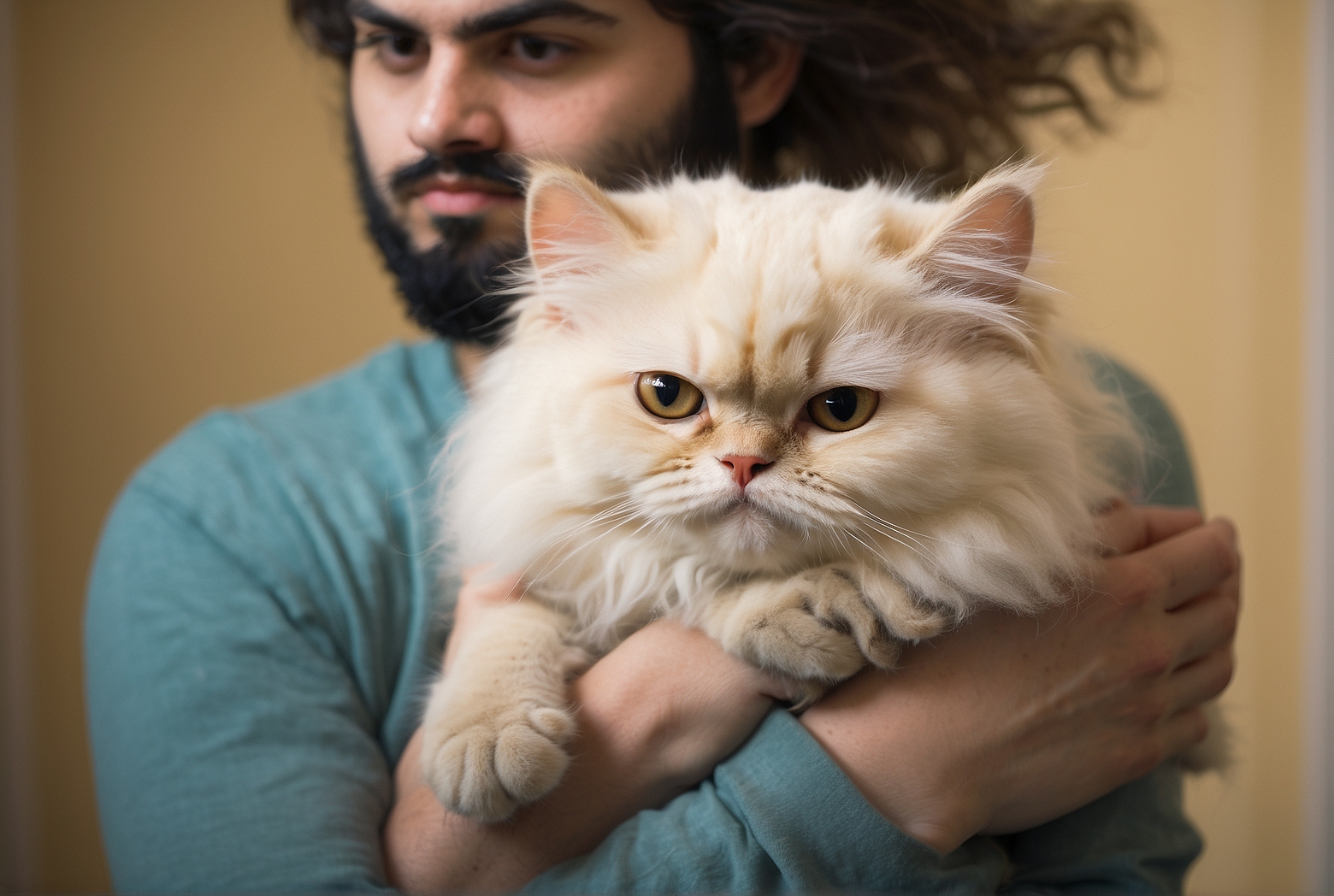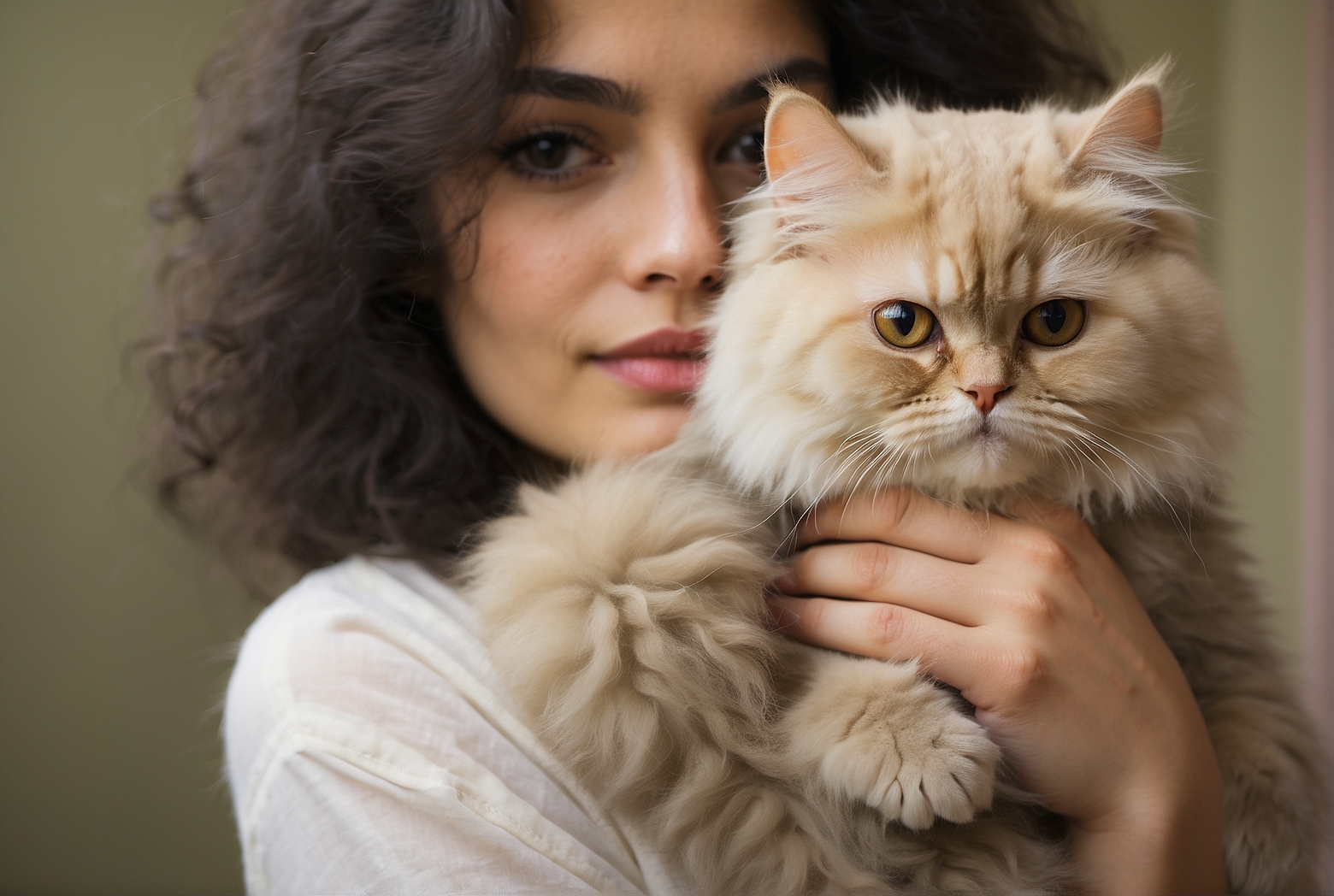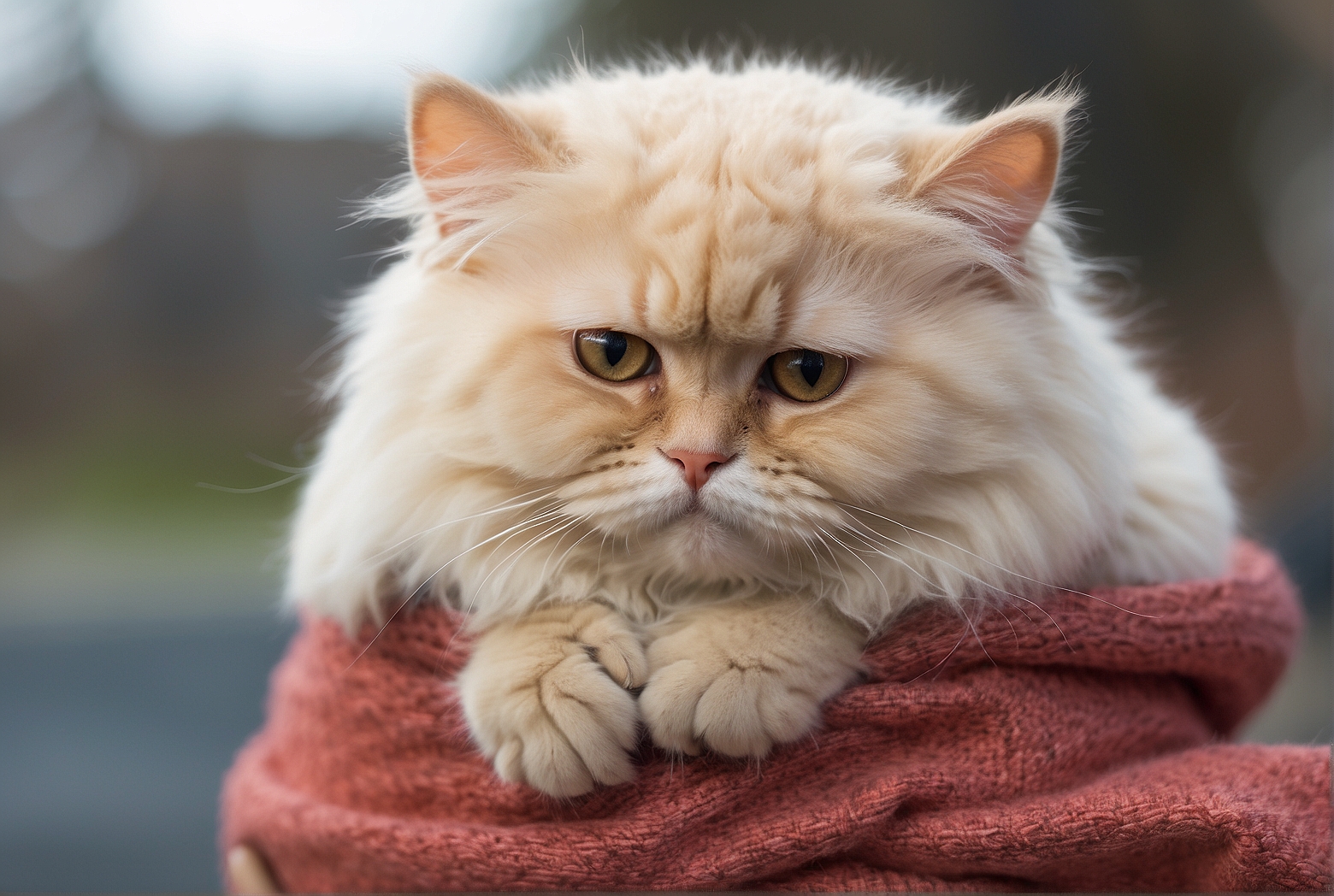Persian cats are renowned for their stunning long fur and regal appearance, but have you ever wondered if they actually enjoy being held? In this article, we explore the fascinating world of Persian cats and delve into their preferences when it comes to the affectionate act of being held. Discover the secrets behind their often-misunderstood behavior and unravel the mystery of whether these elegant felines truly embrace the warm embrace of human touch. Get ready to unveil the truth about Persian cats and their affinity for being cuddled!
Physical Characteristics of Persian Cats
Fluffy and Luxurious Coat
Persian cats are well-known for their long and luxurious coats. Their fur is incredibly soft and fluffy, making them an absolute delight to touch and cuddle. It requires regular grooming to keep their coat in top condition, but the effort is definitely worth it for the pleasure of running your fingers through their silky fur.
Flat Face and Round Eyes
One of the distinguishing features of Persian cats is their flat face. Their muzzle is short and their nose is relatively small, giving them a unique and charming appearance. Paired with their round, expressive eyes, Persian cats have a face that is simply irresistible. Their eyes are usually large and wide-set, further enhancing their adorable and endearing look.
Stocky and Heavy Build
Persian cats have a stocky and heavy build. They have a sturdy body with a muscular frame, which gives them a solid and substantial feel. Despite their heavyset appearance, they are actually quite graceful and agile. Their robust physique adds to their charm and makes them even more huggable and cuddly.
The Nature of Persian Cats
Gentle and Calm Temperament
Persian cats are known for their gentle and calm temperament. They have a serene and peaceful nature that makes them ideal companions for a relaxed and tranquil lifestyle. They are generally not the most active or energetic breed, preferring a laid-back and unhurried pace of life. This gentle nature makes them perfect for individuals or families looking for a serene and undemanding feline companion.
Affectionate and Laid-Back Personality
Persian cats are incredibly affectionate and enjoy the company of their human family members. They thrive on love and attention and are known to form strong bonds with their owners. Despite their regal appearance, they have a down-to-earth and easy-going personality. They appreciate a leisurely lifestyle with plenty of snuggles and soft words of affection.

Preference for a Quiet Environment
Persian cats have a preference for a quiet and calm environment. They enjoy a peaceful and serene atmosphere where they can relax and unwind. Loud noises and busy households can be stressful for them, so it’s important to provide them with a tranquil living space. If you are the type of person who enjoys a quiet and peaceful home, a Persian cat will fit right in and become a cherished member of your family.
Understanding Persian Cats’ Body Language
Tail Position and Movement
The position and movement of a Persian cat’s tail can provide important insights into their mood and emotions. When a Persian cat’s tail is held high and erect, it usually indicates that they are content and confident. A slightly lowered tail can indicate relaxation and a calm state of mind. A flicking or twitching tail, however, can be a sign of agitation or annoyance. It’s important to observe the tail position and movement to understand how your Persian cat is feeling at any given moment.
Ear Position and Movement
The position and movement of a Persian cat’s ears can also reveal a lot about their emotional state. If their ears are pointed forward, it usually indicates that they are attentive and interested in their surroundings. On the other hand, flattened or backward-facing ears can indicate fear, anxiety, or aggression. It’s crucial to pay attention to their ear position and movement to better understand their feelings and respond accordingly.
Purring and Kneading
Purring is a common behavior among Persian cats, and it is usually a sign of contentment and relaxation. When a Persian cat is purring while being held or petted, it’s a clear indication that they are enjoying the experience and feel safe and comfortable in your presence. Additionally, many Persian cats engage in kneading, which involves rhythmically pushing their paws against a soft surface. This behavior is a throwback to their kittenhood and is often seen as a sign of happiness and contentment.
Developing Trust and Bonding with a Persian Cat
Start Slow and Gradual
Developing trust and bonding with a Persian cat requires patience and understanding. Start by allowing the cat to approach you on their terms. Respect their personal space and avoid forcing interactions. Let them come to you when they are ready, and gradually increase the amount of time you spend together. This slow approach will help build trust and make them feel comfortable in your presence.
Offer Treats and Positive Reinforcement
Encourage positive associations by offering treats and rewards when your Persian cat interacts with you or allows you to hold them. This positive reinforcement will help them associate being held with pleasant experiences and create a stronger bond between you. However, it’s important not to overdo it with treats and maintain a balanced diet for your furry friend.

Respect Their Personal Space
It’s crucial to respect your Persian cat’s personal space and boundaries. Avoid sudden movements or intrusive actions that could startle or upset them. Allow them to retreat to their safe spaces when they need some alone time, and never force them to be held if they are showing signs of discomfort or resistance. Respecting their personal preferences will lay the foundation for a trusting and loving relationship.
Benefits of Holding a Persian Cat
Promotes Bonding and Trust
Holding a Persian cat can be a wonderful way to strengthen the bond and trust between you and your feline friend. Physical contact helps them feel safe, loved, and secure. It allows them to experience the warmth and reassurance of your presence, which ultimately deepens your connection. Regular holding sessions can enhance the emotional connection and make your Persian cat feel like an integral part of your life.
Provides Comfort and Security
Being held provides comfort and security to Persian cats. The gentle pressure and warmth of your touch can have a calming effect on them, reducing stress and anxiety. It mimics the feeling of being close to their mother during kittenhood, creating a sense of reassurance and safety. Holding your Persian cat can provide them with a sanctuary of love and care, offering them peace in a sometimes chaotic world.
Stimulates Socialization and Interaction
When you hold a Persian cat, you are engaging in social interaction with them. This physical contact stimulates their socialization skills and helps them develop a better understanding of human behavior. It also provides an opportunity for them to observe and learn from you, which can enhance their overall intelligence and cognitive abilities. Holding your Persian cat encourages socialization and strengthens their ability to form positive relationships with humans.
Signs that a Persian Cat Likes to Be Held
Initiates Physical Contact
If your Persian cat initiates physical contact by climbing onto your lap or rubbing against your legs, it’s a clear sign that they enjoy being held. This proactive behavior indicates that they trust you and feel comfortable seeking affection from you. Pay attention to their cues and respond with love and gentle cuddles.
Purrs and Shows Relaxation
When a Persian cat is being held and starts purring, it’s a sure sign that they are content and relaxed in your arms. Purring is a self-soothing behavior that indicates joy and satisfaction. If your Persian cat is showing these signs while being held, it means they find comfort and enjoyment in your embrace.
Leans into Your Touch
Another way Persian cats show their appreciation for being held is by leaning into your touch. When you hold them, they may press their body against you as a way of seeking more contact and closeness. This physical connection shows that they feel safe and secure in your arms, and it’s a strong indication that they enjoy being held.
Factors Affecting a Persian Cat’s Preference for Being Held
Individual Personality and Background
Just like humans, Persian cats have unique personalities and preferences. Some may naturally enjoy being held more than others. Additionally, their background and upbringing can influence their comfort level with being held. Cats that had positive experiences with human contact from an early age are generally more likely to enjoy being held.
Health and Physical Condition
A Persian cat’s health and physical condition can also impact their preference for being held. If they are experiencing any pain, discomfort, or mobility issues, they may not feel comfortable being held. It’s important to be attentive to their physical well-being and consult with a veterinarian if you notice any changes in their behavior.
Previous Experiences and Socialization
The early experiences and socialization a Persian cat has had can greatly affect their comfort and preference for being held. Cats that have had positive interactions with humans during their early development stages are more likely to enjoy being held as adults. On the other hand, cats with limited exposure to human contact may be more hesitant or skittish when it comes to being held.
Tips for Holding a Persian Cat Comfortably
Use Proper Support and Grip
When holding a Persian cat, it’s important to provide proper support to their body. Cradle them gently with one hand supporting their chest and the other supporting their hindquarters. Avoid squeezing or putting pressure on their delicate organs or limbs. Maintaining a secure and comfortable grip will ensure a pleasant experience for both you and your feline friend.
Choose a Quiet and Comfortable Environment
Select a quiet and comfortable environment for holding your Persian cat. Choose a calm room where they feel safe and at ease. Minimize distractions and noise to create a peaceful atmosphere that promotes relaxation. Softening the lighting and providing a cozy spot can also enhance the overall experience.
Monitor Their Body Language
While holding your Persian cat, pay close attention to their body language and cues. If they start to show signs of discomfort, such as squirming, tensing up, or trying to get away, it’s important to release them gently and respect their boundaries. Their comfort and well-being should always be the top priority.
Alternatives to Holding for Bonding with a Persian Cat
Grooming and Brushing
Grooming and brushing sessions can be an excellent alternative to holding for bonding with your Persian cat. Not only does it help keep their luxurious coat in top condition, but it also provides an opportunity for quiet bonding time. Use a soft brush or comb and gently groom their fur, taking care to be gentle and avoid pulling or tugging. This activity allows you to connect with your Persian cat through touch and promotes a sense of trust and relaxation.
Play and Interactive Toys
Playtime is an essential aspect of bonding with your Persian cat. Engage them in interactive play with toys such as feather wands or catnip mice. This physical activity not only stimulates their natural instincts but also strengthens the bond between you. Playful interactions encourage trust, cooperation, and shared enjoyment, fostering a strong and loving relationship.
Quiet Cuddling and Lap Time
If your Persian cat doesn’t particularly enjoy being held, you can still engage in quiet cuddling and lap time. Create a cozy spot on your lap using a soft blanket or cushion and invite your feline companion to join you. Allow them to snuggle against you, providing warmth, comfort, and gentle affection. This alternative to holding promotes relaxation and bonding without the need for physical restraint.
Respecting a Persian Cat’s Boundaries and Preferences
Observe Their Body Language and Cues
Respecting a Persian cat’s boundaries and preferences starts with observing their body language and cues. If they show signs of discomfort, fear, or aggression, it’s important to give them space and avoid any actions that may further stress or upset them. Every cat is different, and it’s crucial to understand and respect their individual needs and preferences.
Allow for Alone Time and Privacy
Just like humans, Persian cats need alone time and privacy to recharge and relax. It’s important to provide them with a dedicated space where they can retreat and have time to themselves. This allows them to feel safe and in control of their environment, preventing unnecessary stress and promoting overall well-being.
Communicate and Understand Their Needs
Effective communication is key to understanding a Persian cat’s needs and desires. Cats use a variety of vocalizations, body postures, and facial expressions to communicate their thoughts and emotions. Pay attention to their cues and respond accordingly. By acknowledging and understanding their signals, you can build a stronger bond with your Persian cat and foster a loving and harmonious relationship.
In conclusion, Persian cats have unique physical characteristics, gentle temperaments, and preferences that make them distinctive and beloved pets. While some Persian cats enjoy being held and thrive on physical contact, it’s important to respect their boundaries and individual preferences. By developing trust, observing their body language, and providing alternative bonding activities, you can create a strong and loving bond with your Persian cat that goes beyond physical interactions. Remember, each Persian cat is an individual with their own personality, so approach their preferences with openness, patience, and understanding.
